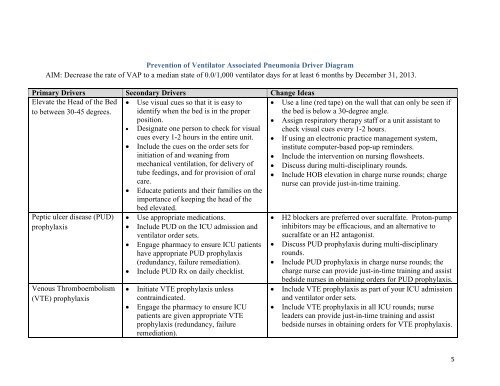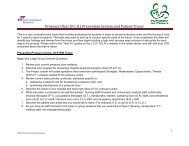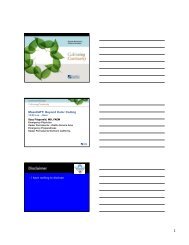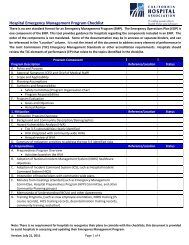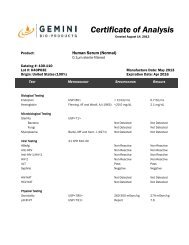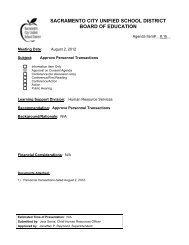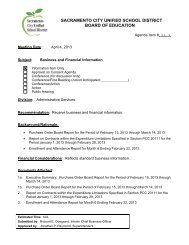(VAP) Driver Diagram
(VAP) Driver Diagram
(VAP) Driver Diagram
Create successful ePaper yourself
Turn your PDF publications into a flip-book with our unique Google optimized e-Paper software.
Prevention of Ventilator Associated Pneumonia <strong>Driver</strong> <strong>Diagram</strong><br />
AIM: Decrease the rate of <strong>VAP</strong> to a median state of 0.0/1,000 ventilator days for at least 6 months by December 31, 2013.<br />
Primary <strong>Driver</strong>s Secondary <strong>Driver</strong>s Change Ideas<br />
Elevate the Head of the Bed<br />
to between 30-45 degrees.<br />
Peptic ulcer disease (PUD)<br />
prophylaxis<br />
Venous Thromboembolism<br />
(VTE) prophylaxis<br />
• Use visual cues so that it is easy to<br />
identify when the bed is in the proper<br />
position.<br />
• Designate one person to check for visual<br />
cues every 1-2 hours in the entire unit.<br />
• Include the cues on the order sets for<br />
initiation of and weaning from<br />
mechanical ventilation, for delivery of<br />
tube feedings, and for provision of oral<br />
care.<br />
• Educate patients and their families on the<br />
importance of keeping the head of the<br />
bed elevated.<br />
• Use appropriate medications.<br />
• Include PUD on the ICU admission and<br />
ventilator order sets.<br />
• Engage pharmacy to ensure ICU patients<br />
have appropriate PUD prophylaxis<br />
(redundancy, failure remediation).<br />
• Include PUD Rx on daily checklist.<br />
• Initiate VTE prophylaxis unless<br />
contraindicated.<br />
• Engage the pharmacy to ensure ICU<br />
patients are given appropriate VTE<br />
prophylaxis (redundancy, failure<br />
remediation).<br />
• Use a line (red tape) on the wall that can only be seen if<br />
the bed is below a 30-degree angle.<br />
• Assign respiratory therapy staff or a unit assistant to<br />
check visual cues every 1-2 hours.<br />
• If using an electronic practice management system,<br />
institute computer-based pop-up reminders.<br />
• Include the intervention on nursing flowsheets.<br />
• Discuss during multi-disciplinary rounds.<br />
• Include HOB elevation in charge nurse rounds; charge<br />
nurse can provide just-in-time training.<br />
• H2 blockers are preferred over sucralfate. Proton-pump<br />
inhibitors may be efficacious, and an alternative to<br />
sucralfate or an H2 antagonist.<br />
• Discuss PUD prophylaxis during multi-disciplinary<br />
rounds.<br />
• Include PUD prophylaxis in charge nurse rounds; the<br />
charge nurse can provide just-in-time training and assist<br />
bedside nurses in obtaining orders for PUD prophylaxis.<br />
• Include VTE prophylaxis as part of your ICU admission<br />
and ventilator order sets.<br />
• Include VTE prophylaxis in all ICU rounds; nurse<br />
leaders can provide just-in-time training and assist<br />
bedside nurses in obtaining orders for VTE prophylaxis.<br />
5
Primary <strong>Driver</strong>s Secondary <strong>Driver</strong>s Change Ideas<br />
• Include VTE prophylaxis on daily<br />
checklist<br />
ABCDE Bundle • “A & B” – Develop protocols, order<br />
sets, and standard work procedures for<br />
Spontaneous Awakening Trials (SAT)<br />
and Spontaneous Breathing Trials (SBT).<br />
• “C” – Coordinate SAT and SBT to<br />
maximize weaning opportunities when<br />
patient sedation is minimal.<br />
• “D” – Sedation should be goal-oriented.<br />
• “E” – Early progressive mobilization and<br />
ambulation.<br />
Oral Care • Perform regular oral care with an<br />
antiseptic solution, brush teeth, and<br />
perform oral and pharyngeal suctioning.<br />
• Perform daily assessments of readiness to wean and<br />
extubate.<br />
• Provide a daily reduction or removal of sedative<br />
support.<br />
• Designate one time of the day for the SAT and SBT to<br />
be attempted.<br />
• Coordinate between nursing and respiratory therapy to<br />
manage SAT and SBT. Use whiteboards, the EMR or<br />
other communication tools to enhance coordination.<br />
• Discuss the results of the SAT and SBT during daily<br />
multi-disciplinary rounds.<br />
• The SAT and SBT should be included in nurse-to-nurse<br />
handoffs, nurse-to-charge nurse reports, and charge<br />
nurse-to-charge nurse reports (if they occur).<br />
• Administer sedation as ordered by the physician<br />
according to a scale such as a RASS 1 or Modified<br />
Ramsey Score.<br />
• Modify ICU orders to default activity level to “as<br />
tolerated.”<br />
• Implement an early progressive mobility protocol.<br />
• Include teeth brushing twice a day in order sets for all<br />
ventilated patients. 23<br />
• Include routine oral care every 2-4 hours with an<br />
1 Richmond Agitation Sedation Scale (RASS)<br />
2 Munro CL, Grap MJ, Jones DI, McClish DK, Sessler CN. Chlorhexidine, tooth brushing and preventing ventilator-associated<br />
pneumonia in critically ill adults. Am J Crit Care. 2009; 18(5):428-437.<br />
3 Garcia R, Jendresky L, Colbert L, Bailey A, Zaman M, Majumder M. Reducing ventilator-associated pneumonia through advanced<br />
oral-dental care: A 48-month study. Am K Crit Care. 2009; 18(6):523-532.<br />
6
Primary <strong>Driver</strong>s Secondary <strong>Driver</strong>s Change Ideas<br />
• Educate the RN staff about the rationale<br />
supporting good oral hygiene and its<br />
antiseptic mouthwash swab to clean the oral cavity and<br />
teeth.<br />
potential benefit in reducing ventilatorassociated<br />
pneumonia.<br />
• Use Chlorhexidine 0.12% mouthwash at least daily<br />
(many studies cite every 12 hours) as part of order sets<br />
for all ventilated patients. 4<br />
• Create visual cues (e.g. empty holders of oral care<br />
products) to indicate compliance with oral care.<br />
• Include Respiratory Therapy in performing oral care,<br />
make it a joint RN and RT function.<br />
4<br />
Chan EY, Ruest A, O’Meade M, Cook DJ. Oral decontamination for prevention of pneumonia in mechanically ventilated adults:<br />
Systematic review and meta-analysis. Brit Med J. 2007; 10:1136.<br />
7


